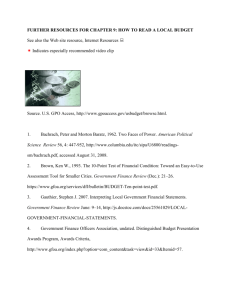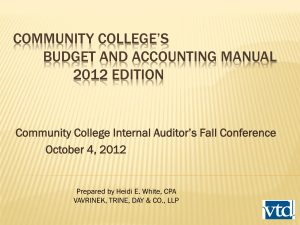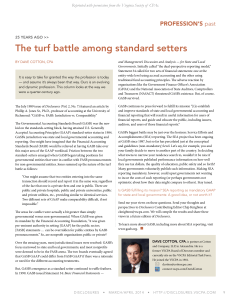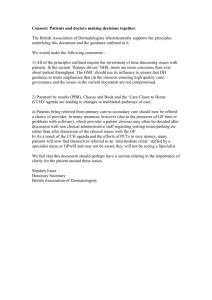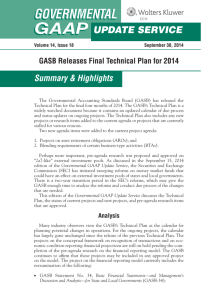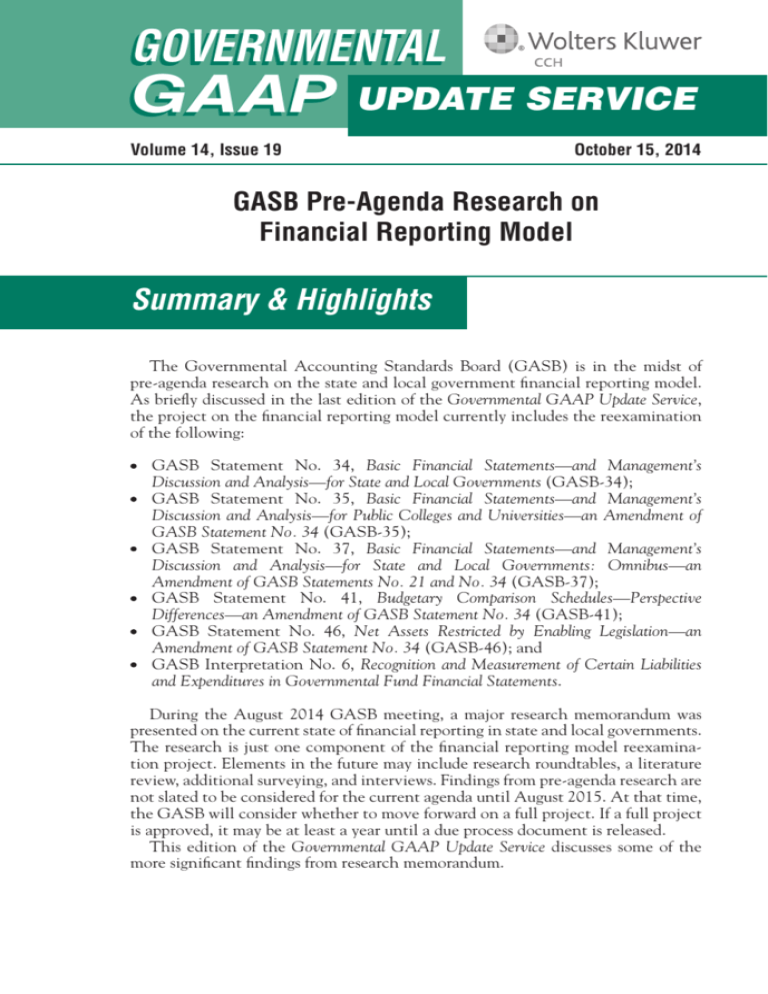
GOVERNMENTAL
GAAP UPDATE SERVICE
Volume 14, Issue 19
October 15, 2014
GASB Pre-Agenda Research on
Financial Reporting Model
Summary & Highlights
The Governmental Accounting Standards Board (GASB) is in the midst of
pre-agenda research on the state and local government financial reporting model.
As briefly discussed in the last edition of the Governmental GAAP Update Service,
the project on the financial reporting model currently includes the reexamination
of the following:
GASB Statement No. 34, Basic Financial Statements—and Management’s
Discussion and Analysis—for State and Local Governments (GASB-34);
GASB Statement No. 35, Basic Financial Statements—and Management’s
Discussion and Analysis—for Public Colleges and Universities—an Amendment of
GASB Statement No. 34 (GASB-35);
GASB Statement No. 37, Basic Financial Statements—and Management’s
Discussion and Analysis—for State and Local Governments: Omnibus—an
Amendment of GASB Statements No. 21 and No. 34 (GASB-37);
GASB Statement No. 41, Budgetary Comparison Schedules—Perspective
Differences—an Amendment of GASB Statement No. 34 (GASB-41);
GASB Statement No. 46, Net Assets Restricted by Enabling Legislation—an
Amendment of GASB Statement No. 34 (GASB-46); and
GASB Interpretation No. 6, Recognition and Measurement of Certain Liabilities
and Expenditures in Governmental Fund Financial Statements.
During the August 2014 GASB meeting, a major research memorandum was
presented on the current state of financial reporting in state and local governments.
The research is just one component of the financial reporting model reexamination project. Elements in the future may include research roundtables, a literature
review, additional surveying, and interviews. Findings from pre-agenda research are
not slated to be considered for the current agenda until August 2015. At that time,
the GASB will consider whether to move forward on a full project. If a full project
is approved, it may be at least a year until a due process document is released.
This edition of the Governmental GAAP Update Service discusses some of the
more significant findings from research memorandum.
Analysis
From June 1999 through periods that began after June 15, 2003, state and local
governments implemented the current financial reporting model as originally
released in GASB-34. Since June 15, 2003, the model has been amended at least
nine times, including the primary releases listed above.
However, the GASB staff research presented at the August 2014 GASB
meeting disclosed that some governments may have chosen to not implement
all provisions of GASB-34 even though they have issued comprehensive annual
financial reports (CAFRs). The GASB staff reviewed a wide sample of CAFRs
of states, counties, cities, independent school districts, special-purpose districts,
and colleges and universities with a goal of understanding and identifying how
the specific requirements for management’s discussion and analysis (MD&A),
government-wide financial statements, fund financial statements (if applicable), notes to the financial statements, and required supplementary information
(RSI) are being met. The population from which the selections of governments
were taken was the list of 87,959 governments included in the 2007 Census of
Governments. A total of 495 governments were selected among three strata of
governments based on revenues, which was the same strata break points contained in GASB-34:
Phase 1 governments to implement GASB-34 had revenues of $100 million
or more;
Phase 2 governments had more than $10 million in revenues, but less than $100
million; and
Phase 3 governments were the smallest governments.
The survey included all 50 states, along with each of the 50 largest counties,
cities, and school districts. The 25 largest special purpose districts and the 10 largest public colleges and universities were all in Phase 1 of the selections. Phase 2
contained 155 governments and Phase 3 contained 105 governments.
Many circumstances were found in which U.S. generally accepted accounting
principles (U.S. GAAP) was not followed in small- and medium-sized governments. Of the largest governments, U.S. GAAP may not be followed by over 5%
of governments nationwide. This number rises to over 22% in medium-sized governments and 47% in smaller governments. Of the largest governments, except
for states, every type of government had some component of not implementing
U.S. GAAP.
Remarkably, four states had U.S. GAAP compliance issues as found by the
GASB staff. On average, 17% of counties, 11% of cities, 14% of school districts,
and 11% of special purpose districts had some form of U.S. GAAP compliance
issues. No colleges and universities surveyed were found to not follow U.S. GAAP.
The primary reason for a lack of compliance was the failure to include the
MD&A. Every state included an MD&A. The largest group not including the
MD&A was counties. The next largest compliance issue was a failure to include
a component unit. Remarkably, three financial statements were issued without an
auditor’s opinion!
For governments that did include an MD&A, the largest issue within the
MD&A continues to be the lack of presentation of known facts, decisions, and
conditions as required by paragraph 11(h) of GASB-34. This problem is common—especially in cities and special purpose districts. Budget information and
2
©2014 CCH Incorporated. All Rights Reserved.
revenue projections however are presented in the vast majority of MD&As.
Other items that are common include economic development, including if a new
employer locates in the jurisdiction.
Information in Government-Wide Financial Statements
GASB-34 allows for a small amount of alternative formats in reporting. One
alternative is to present a total column for the entity as a whole. Another alternative is to present prior-year data. Both are not required.
The vast majority of cities, school districts, and public colleges and universities
present a total column for the entity as a whole in a statement of net position.
However, no states present totals or prior-year data. Only colleges and universities
and large special purpose districts regularly present prior-year data.
There is also flexibility in the format of the statement of net position allowed
in GASB-34, as amended. Governments may display assets, plus deferred outflows
of resources, less liabilities, less deferred inflows of resources resulting in net position. Alternatively, governments may present a balance sheet format—assets plus
deferred outflows of resources equals liabilities, plus deferred inflows of resources
plus net position. Every state and the vast majority of counties, cities, and school
districts present a standard statement of net position format. However, the majority of small special purpose districts and small colleges and universities present in a
balance sheet format.
In the statement of activities sampled, the largest amounts of general revenues reported were obviously taxes. Investment earnings, grants and contributions, gains on sales, and “other” were also prevalent. For expenses, school
districts reported the most number of programs and activities, averaging over 11
separate programs and activities nationwide. Special purpose districts of course
had the least amount of programs reporting as few as approximately three programs. Usually, special purpose districts have few functions or programs. The
majority of extraordinary items reported usually related to impairment of capital
assets. Special items are rarely reported, mainly related to gains or losses on the
sales of capital assets.
Governmental Major Fund Reporting
Nationwide, the GASB staff found that small counties reported the most major
governmental funds, averaging over four funds. The least amount of major governmental funds reported were at special purpose districts, which typically are
not governmental activities, or they have only a general fund and maybe one
other fund. In the sample, small counties also reported the most major special revenue funds—nearly two. Very few governments reported major debt service funds.
Counties and school districts tended to report approximately one major capital
project fund. No major permanent funds were reported, other than at states and
large special purpose districts.
Major Enterprise Fund Reporting
States and large cities typically have the most major enterprise funds due to the
scope of their operations. On average, states and large cities reported over three
major enterprise funds. Large special purpose districts, large counties, and other
sized cities typically reported two major enterprise funds.
©2014 CCH Incorporated. All Rights Reserved.
3
Restricted Resource Usage
Paragraph 115(h) of GASB-34 requires governments to disclose their policy regarding whether to first apply restricted or unrestricted resources when an
expense is incurred for purposes in which both restricted and unrestricted net position is available. Nearly every type and size of government uses restricted resources
first and then unrestricted resources, typically due to federal grant and the spending
of bond proceeds restrictions. For public colleges and universities, the majority of
larger institutions did not spend restricted resources first, largely due to the operations of endowments. The most restricted net position due to enabling legislation
was reported at states.
Defining Operating and Non-Operating Revenues and Expenses
GASB-34 requires the disclosure of a policy for defining operating revenues and
expenses for proprietary funds. One of the more common descriptions identified
in the sample was “operating revenues and expenses result from providing services
and delivering goods in connection with the fund’s principal ongoing operations.”
These operations could include activities of the operations of the fund, categories
of revenues, or major types of revenues and expenses. The majority of governments
sampled of all sizes use some variation of these ongoing operations concepts to
define what is an operating and a non-operating revenue or expense. The second
most common definition used some form of exchange to define operating and nonoperating revenues and expenses.
Segment Reporting
Since the issuance of GASB-34, segment reporting has not been uniform
nationwide and the survey results proved as such. Paragraph 122 in GASB-34
defines segments as identifiable activities (or grouping of activities) reported as
or within an enterprise fund or a stand-alone entity that has one or more bond or
other debt instruments outstanding, with a revenue stream pledged in support of
that debt. Of those governments that reported segments, less than 30% of states
and only 20% of medium-sized colleges and universities reported segments. Given
the level of major enterprise fund reporting noted in the survey, this signals a
potential problem in understanding U.S. GAAP because most enterprise funds
have some form of debt issued.
Budgetary Comparison Reporting
Paragraph 130 of GASB-34 allows variability in reporting budgetary comparison
schedules. The schedules may be reported as required supplementary information
or as a basic financial statement. Nearly every government reports the schedules as
required supplementary information using a final budget to actual variance column.
Very few governments report an original budget to final variance column even
though some believe that the alternative comparison is more meaningful—gauging
the effectiveness of budgeting and controls. Governments typically use a statement
of revenue, expenses, and changes in fund balances format to present this information even though there are alternatives available. As expected, presenting budgetary comparison information using a U.S. GAAP fund structure is not uniform
because most budgetary operations are not U.S. GAAP.
4
©2014 CCH Incorporated. All Rights Reserved.
Conclusion
As exhaustive as this information may seem, there is still almost a year of analysis, interviews, roundtable discussions, surveying, and other activities ahead for
the GASB staff prior to a recommendation to the GASB of further action, or no
further action, in the reexamination of the financial reporting model. There have
been many calls for financial statement streamlining and simplification at conferences and meetings where GASB members and staff have attended. However, the
data show a relatively high level of compliance with the current model, which
is likely due to state laws, bond documents, or other restrictions requiring U.S.
GAAP compliance. There are still plenty of smaller governments that report in
accordance with a special purpose framework as well.
This important project will have many twists and turns over the next year or
perhaps the next few years. However, each twist and turn will give preparers, users,
and other stakeholders an opportunity to voice their opinion on which direction to
go. Preparers, users, and other stakeholders should take advantage of the opportunity to indicate whether or not they want change. After all, these may be the only
opportunities to change the financial reporting model for the next decade or so.
About the Author
Eric S. Berman, MSA, CPA, CGMA, has over 24 years of governmental
accounting and auditing experience and is a partner with Eide Bailly LLP.
Previous to Eide Bailly LLP, he was a quality control principal with a public
accounting firm in California. His public sector experience includes being a
Deputy Comptroller for the Commonwealth of Massachusetts from 1999 to
2010, and the Chief Financial Officer of the Massachusetts Water Pollution
Abatement Trust from 1994 to 1999. Eric is a licensed CPA in Massachusetts.
He obtained an M.S. in Accountancy from Bentley University. Eric
recently represented the Association of Government Accountants (AGA)
as the Vice Chairman of the Government Accounting Standards Advisory
Council to GASB. He currently chairs the AGA’s Financial Management
Standards Board. He also is a previous chair of the American Institute of
Certified Public Accountants (AICPA) Governmental Performance and
Accountability Committee and is a former member of the AICPA’s State and
Local Government Expert Panel. Eric is frequently called upon to consult and
train state and local governments throughout the country on governmental
accounting and auditing.
©2014 CCH Incorporated. All Rights Reserved.
5
LEADING ACCOUNTING AND AUDIT INFORMATION
AND TOOLS FOR PROFESSIONALS
CCH, a part of Wolters Kluwer, offers a suite of accounting and
audit information and products featuring in-depth analysis, guidance,
and solutions in a full range of media—from guides, practice manuals,
and treatises to journals, newsletters, and Internet research libraries.
Make CCH your source for accounting guidance with comprehensive,
timesaving products, including:
• Accounting Research
Manager
• Governmental GAAP
Practice Manual
• GAAP Guide
• Knowledge-Based Audits
of State and Local
Governments with Single
Audits
• Governmental GAAP
Guide
To order or for more information on these and other CCH products
and services, call 1-800-248-3248 or visit the CCH Online Store at
CCHGroup.com.
6
©2014 CCH Incorporated. All Rights Reserved.
ACCO UNTING RE SE A RCH M ANAGER®
Accounting Research Manager is the accounting industry’s largest and most
comprehensive online database, providing easy access to objective and insightful
government, accounting, auditing, and SEC information. While other research
tools simply summarize the authoritative literature, leaving you to decipher oftencomplex information, Accounting Research Manager goes the extra mile to give
you the clearest possible picture. We bring clarity to your government and financial
reporting research.
The Government Library
The Accounting Research Manager Government Library provides one-stop
access to governmental authoritative and proposal stage literature including:
• GASB (Governmental Accounting Standards Board) Statements &
Interpretations, Technical Bulletins, Implementation Guides & related
proposal stage literature
• GAO (Government Accountability Office) Governmental Auditing
Standards, Financial Audit Manual
• OMB (Office of Management and Budget) Circulars, Compliance Supplements
The Government Library also offers in-depth, interpretive guidance. Users can
access our Government titles that include the Governmental GAAP Guide,
Governmental GAAP Practice Manual, Knowledge-Based Audits of State and Local
Governments with Single Audits, and the Governmental GAAP Update Service.
Learn more about Accounting Research Manager and request your free trial at
www.accountingresearchmanager.com.
©2014 CCH Incorporated. All Rights Reserved.
7
CCH LEARNING CENTER
CCH’s goal is to provide you with the clearest, most concise, and
up-to-date accounting and auditing information to help further your
professional development, as well as a convenient method to help you
satisfy your continuing professional education requirements. The CCH
Learning Center* offers a complete line of self-study courses covering
complex and constantly evolving accounting and auditing issues. We are
continually adding new courses to the library to help you stay current
on all the latest developments. The CCH Learning Center courses are
available 24 hours a day, seven days a week. You’ll get immediate exam
results and certification. To view our complete accounting and auditing
course catalog, go to: http://cch.learningcenter.com.
* CCH, a part of Wolters Kluwer, is registered with the National Association of State Boards
of Accountancy (NASBA) as a sponsor of continuing professional education on the National
Registry of CPE Sponsors. State boards of accountancy have final authority on the acceptance
of individual courses for CPE credit. Complaints regarding registered sponsors may be
addressed to the National Registry of CPE Sponsors, 150 Fourth Avenue North, Nashville,
TN 37219-2417. Telephone: 615-880-4200.
* CCH, a part of Wolters Kluwer, is registered with the National Association of State
Boards of Accountancy as a Quality Assurance Service (QAS) sponsor of continuing
professional education. Participating state boards of accountancy have final authority on
the acceptance of individual courses for CPE credit. Complaints regarding QAS program
sponsors may be addressed to NASBA, 150 Fourth Avenue North, Suite 700, Nashville,
TN 37219-2417. Telephone: 615-880-4200.
Eric S. Berman, partner with Eide Bailly, authors articles twice a month via CCH.
For more information on subscribing to the service allowing you to receive these
articles upon release, Click here
He also authors CCH's Governmental GAAP Library which is available in print or
e-book
8
©2014 CCH Incorporated. All Rights Reserved.
MGGS

